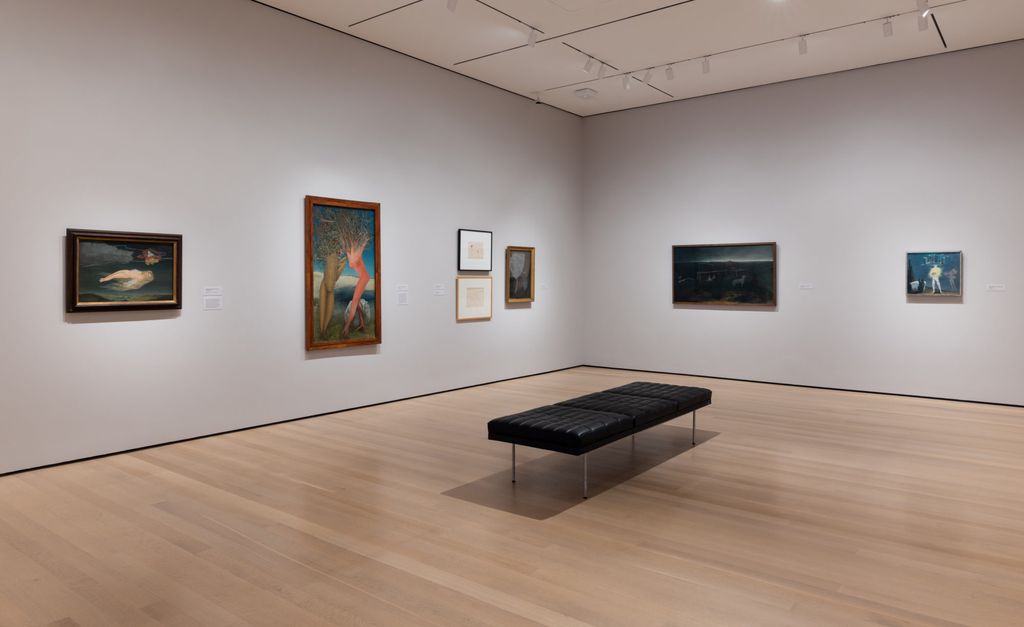Meret Oppenheim: My Exhibition
Museum of Modern Art, New York
October 30, 2022–March 4, 2023
by Katherine Gregory

Upon hearing the name Meret Oppenheim (1913–1985, Germany), any person who has taken an introductory art history course will picture her fur-covered cup Le Déjuner en Fourrure (1936) (fig. 1). This sculpture has come to stand for Oppenheim’s entire oeuvre and, as such, has retroactively established her in the public consciousness as the feminist leader of the Surrealists. Oppenheim herself, however, resisted such gendered categorization of her fifty-year career that produced hundreds of works, ranging from paper collages to hard-edged abstractions to figurative painting and experimental photography. Oppenheim did not want to be thought of as just a woman artist or just a Surrealist, and thus she declined to be interviewed for or have any works reproduced in the definitive survey Women Artists and the Surrealist Movement (1985). The recent traveling exhibition Meret Oppenheim: My Exhibition, currently at MoMA, aims to transform that popular understanding of the artist, showcase the breadth of her output, and let her diverse artworks speak for themselves (fig. 2).
Organized chronologically, the exhibition opens with Oppenheim’s precocious debut with the Surrealists in Paris at age eighteen. Her early assemblages like Fur Gloves with Wooden Fingers (1936) are both feminine (with polished red nails) and outrageously grotesque (disembodied and eerily lifelike). These works invite her viewer to imagine touching and tasting these uncanny objects that simultaneously repel any possibility of sexual pleasure. In terms of the idea of “spectacle,” few artists seem more relevant than Oppenheim, whose titanic output has played with viewers’ ideas of the absurd, the horrific, the titillating, and the beautiful. The early Surrealist works (in the first rooms of the exhibition) exemplify the movement’s fascination with dreams, the subconscious, and the power of both to transform the world through enthusiastic creative expression.

The exhibition then discusses Oppenheim’s prewar figurative painting, paying close attention to the artist’s engagement with fairy tales and legends. In 1937, Oppenheim left Paris because of the growing political tension in Europe. After fleeing Paris for rural Basel in the lead-up to World War II, she painted The Suffering of Genevieve (1939) (fig. 2), based on a fable about a banished young woman. The artist painted a nude, armless woman, circled by her golden hair, floating through the black night. The helpless yet beautiful woman (defined by Anglo-European standards of female perfection) embodies the spectacular disempowerment of female artists, celebrated for their feminine grace yet disarmed and thus unable to make unpleasant artistic or political statements. The curators suggest Oppenheim felt kinship with this character as an exile far from her creative home in Paris.
Although Oppenheim experimented with different media and expressive painting styles throughout her life, she often returned to familiar themes or stories. In 1954, Oppenheim began renting a new studio space in Bern and producing work that engaged with the Pop and Nouveau Realisme movements. Genevieve and Four Echoes retells the myth from her 1939 work in biomorphic abstraction, with curving, clover-shaped planes of color standing in for the fable’s titular character. Several galleries pay substantial attention to Oppenheim’s abstract paintings, collages, and sculptures, encouraging us to consider her non-figurative works with equal reverence as her well-known Surrealist assemblages. Oppenheim’s abstract works stun the viewer with their simple magnitude: she evokes natural shapes, pairs of lovers, or her own body with a language of forms that is both subtle and unambiguous. There She Flies, the Beloved (1975) is a painting depicting a hermaphroditic shape – both phallic and triangular – rocketing across the picture plane. Oppenheim believed in a “dual-sex spirit” present in herself, and that delineating a hard line between “male” and “female” forms or themes belittled the creative impulse that powered her work. Here, we might consider the spectacular power of deconstructing the gender binary in such an unambiguous, powerful visual language, playing on and breaking up “gendered” shapes with vivid turquoise paint, richly textured tortoiseshell, and molded plastic shapes.
The title of the Museum of Modern Art’s exhibition originates from a series of drawings Oppenheim produced in the final years of her life (fig. 3). Titled My Exhibition, the artist designed her own retrospective with a suite of drawings chronologically organized that depict miniaturized and scaled colored sketches of 200 works. Placed as a mid-exhibition pause, MoMA presents the entire suite of drawings in their own gallery, so that the viewer might see how Oppenheim conceived of her own career as an elder artist. MoMA’s exhibition celebrates Oppenheim by prioritizing the artist’s vision of her own career, encouraging the viewer to reconsider how they have previously considered Oppenheim’s work and how they might expand their understanding of her. One might, as Oppenheim herself wanted, to centralize the spectacular, not just the surreal, in her work.

____________________
Katherine Gregory is an Art History PhD candidate at the University of Texas at Austin. A scholar of American art history, she is writing her dissertation on Robert S. Duncanson’s landscape paintings. She is the recipient of a 2022–2023 Luce/ ACLS Dissertation Fellowship.
____________________